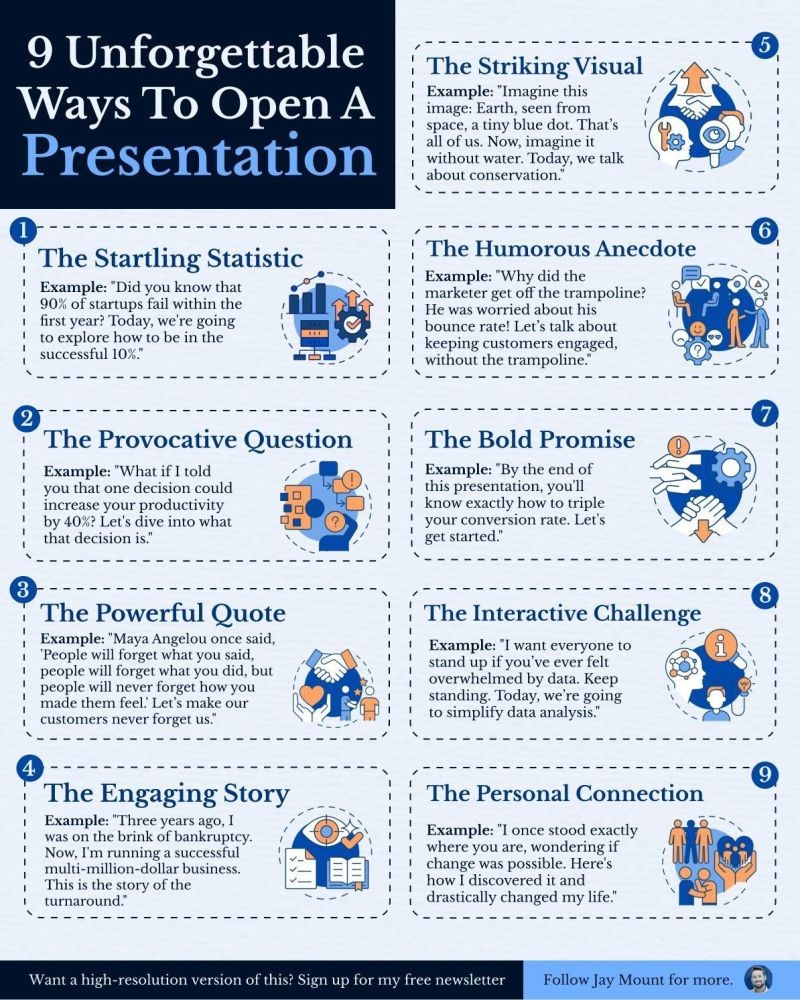3. Craft Powerful Openings that Grab Audience Attention
You step up to speak. The audience is multitasking—checking phones, whispering side comments, mentally elsewhere. Then you open your mouth, say your first sentence, and everything shifts. Heads turn. Eyes focus. The room gets quiet.
Congratulations—you’ve just nailed one of the hardest parts of presenting: capturing attention immediately.
A strong opening isn’t a throwaway moment. It’s your first impression, your hook, your chance to set the tone and earn the audience’s focus. Done well, it makes people lean in. Done poorly, it invites them to zone out.
Let’s explore a few strategies for crafting opening lines that wake up your audience and get them invested from the very start.

Jay Mount’s framework shows how different audiences respond to different types of openings, we will focus on 6 for our purposes, but it gives another insight on how important a repertoire of openings can be to invite you audience into the subject you are about to discuss, present, or sell.
Opening Strategy #1: Start with a Surprising Statistic or Fact
People love to be surprised—especially by something that challenges their assumptions. A well-chosen statistic or unexpected fact can spark curiosity and set up your topic with a bang.
Example:
Weak: “Let’s talk about cybersecurity today.”
Strong: “Every 39 seconds, a cyberattack happens somewhere in the world. That means by the end of this sentence, someone’s already been hacked.”
You’ve instantly raised the stakes—and their eyebrows.
Opening Strategy #2: Pose a Provocative Question
Questions pull the audience into your thought process. They create a mental itch that demands to be scratched.
Example:
Weak: “Today, I’m going to talk about time management.”
Strong: “If I gave you five extra hours each week, what would you do with them?”
Now they’re engaged—and picturing the answer.
Opening Strategy #3: Share a Compelling Story or Anecdote
We’re wired to love stories. Even a brief personal anecdote humanizes you, builds rapport, and makes your message relatable.
Example:
Weak: “This presentation is about customer service.”
Strong: “Last summer, I got a call from a panicked client—ten minutes before the weekend. Instead of passing the buck, our rep Sarah stayed late and solved the issue. That client’s now one of our most loyal.”
Suddenly, it’s not just about metrics. It’s about people.
Opening Strategy #4: Make a Bold or Unexpected Statement
A strong, even slightly controversial opening statement piques interest and challenges your audience to think.
Example:
Weak: “Let’s look at productivity strategies.”
Strong: “Multitasking is the biggest lie in modern work culture—and it’s killing your productivity.”
Now they want to hear why.
Opening Strategy #5: Create Curiosity with a Tease
Sometimes the best way to get attention is to hold something back—just enough to make your audience want more.
Example:
Weak: “This session covers customer satisfaction.”
Strong: “I’m going to reveal one simple change that doubled our customer satisfaction ratings—and no, it’s not better training.”
That curiosity creates momentum for everything that follows.
Opening Strategy #6: Use Humor (Appropriately)
Humor is disarming. It creates warmth and approachability. Just make sure it fits the context, your audience, and your brand.
Example:
Weak: “Let’s talk about managing email.”
Strong: “If your inbox has more unread messages than your Netflix watchlist has episodes, we need to talk.”
Humor invites people in—especially when it’s relatable.
Quick Checklist: What Makes an Opening Effective?
When drafting your opening, ask:
✅ Is it surprising, funny, relatable, or provocative?
✅ Does it immediately connect to the core message?
✅ Am I grabbing attention without overwhelming or confusing?
✅ Does it make the audience want to hear what comes next?
Your opening should act like a well-designed headline—hooking attention and previewing value.
Real-World Scenario: Using a Powerful Opening
Let’s say you’re introducing a flexible work policy:
Weak: “We’ve been reviewing our employee schedule policies.”
Strong: “What if you could get your work done, stay fully engaged—and still pick your kid up from school every day? Flexible schedules can make that possible.”
Which one would you rather listen to?
Final Thoughts: Hook First, Explain Second
Great presentations start with impact. Your audience decides in the first few moments whether you’re worth paying attention to. Make those moments count by using surprise, humor, questions, or emotion to draw them in.
Once they’re hooked, you’ll have the space to unpack your message, share data, and guide them through your ideas. But first—you’ve got to get them to look up from their phones.
Want to keep that engagement going? Next up, we’ll explore how to support your key points with visuals, stories, and persuasive evidence.
